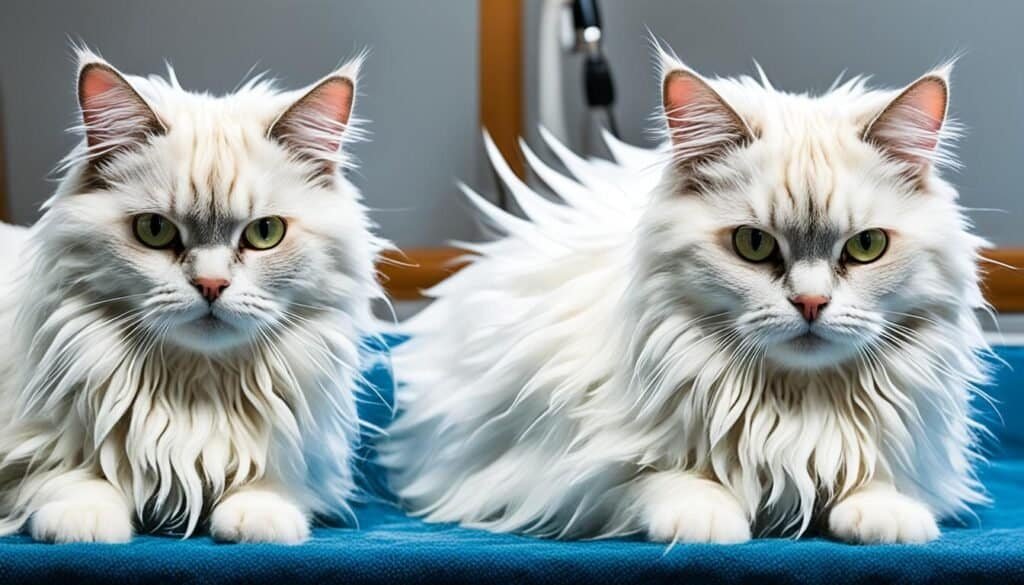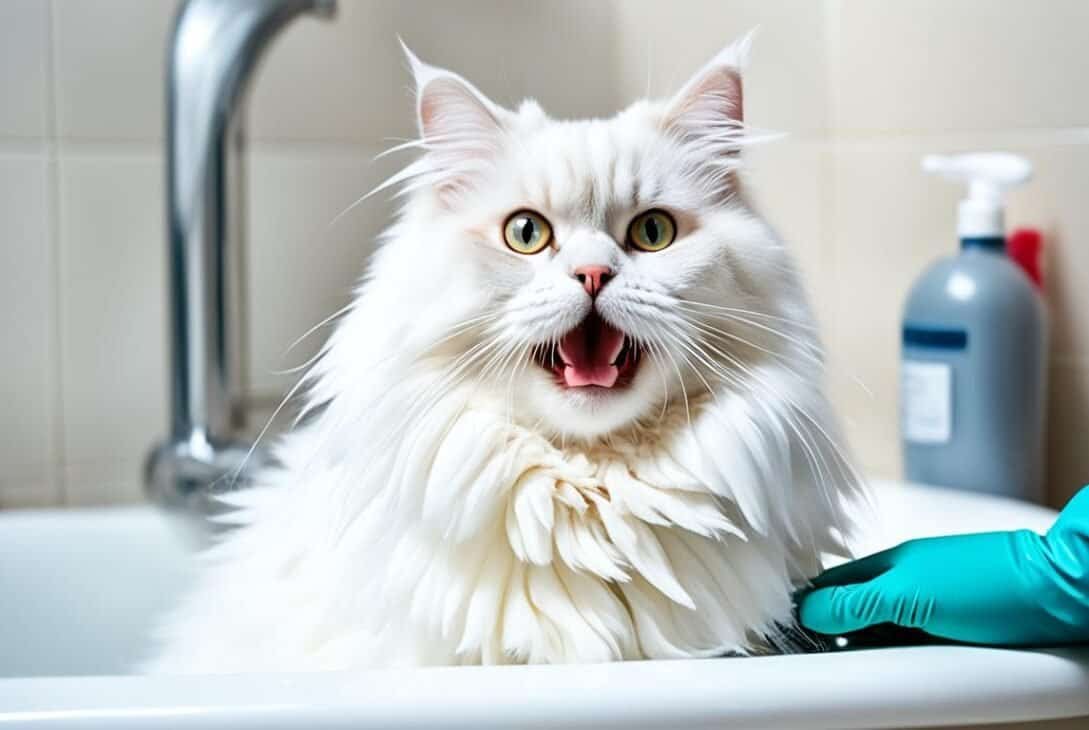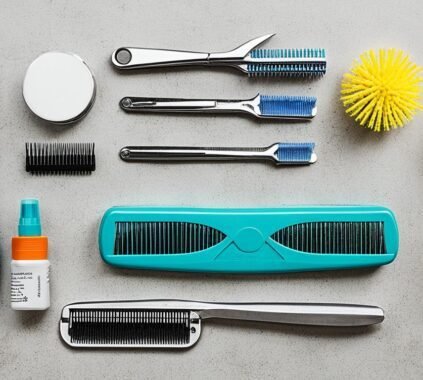Cats are known for their grooming habits, but sometimes they may need help staying clean. If you’re a cat owner, learning how to bathe a cat can be a valuable skill to have.
In this comprehensive guide, we will provide you with essential tips for washing your cat and making the process as stress-free as possible. From preparing the right supplies to rewarding your furry friend after the bath, we’ve got you covered.
Before diving into the tips, it’s important to remember that cats generally groom themselves and don’t require frequent baths. However, certain situations, such as when they get into something sticky or encounter skin issues, may call for a bath.
Now, let’s explore the key steps and considerations in effective cat bathing.
Key Takeaways
- Regular cat grooming is usually sufficient, but occasional baths may be necessary.
- Prepare all the necessary supplies before starting the bathing process.
- Trim your cat’s nails to minimize scratching during the bath.
- Use a pour-over method to wet your cat’s fur and avoid stressing them with running water.
- Choose a cat shampoo that is specifically formulated for feline use.
Understanding a Cat’s Natural Grooming Abilities
Cats are experts when it comes to keeping themselves clean. Their natural grooming abilities ensure that their coats remain shiny and healthy. Understanding how cats groom themselves can help cat owners appreciate the unique qualities of their feline companions.
Cat’s Tongue and Papillae: A cat’s tongue is covered in tiny, backward-facing barbs called papillae. These barbs act like a built-in comb, effectively removing dirt, debris, and loose fur from the cat’s coat. As the cat licks itself, these barbs also stimulate the skin, promoting blood flow and aiding in the distribution of natural oils.
Cleaning and Spreading Natural Oils: Through grooming, cats also spread natural oils produced by their skin onto their fur. These oils serve as a protective layer, keeping the coat moisturized, soft, and resistant to dirt. The cat’s grooming process ensures that these oils are evenly distributed, giving the coat a healthy sheen.
Flexibility and Agility: Cats are known for their remarkable flexibility and agility, which allows them to groom even hard-to-reach areas of their bodies. They can twist, turn, and contort themselves to groom every inch of their fur, ensuring cleanliness and removing any tangles or mats that may form.
Self-Cooling Mechanism: Grooming also plays a vital role in a cat’s self-cooling mechanism. As the cat licks its fur, the saliva evaporates, creating a cooling effect on the skin. This helps regulate body temperature and keeps the cat comfortable, especially in hot weather.
Observing a cat’s grooming routine can be fascinating. From their meticulous tongue cleaning to their graceful contortions, cats demonstrate remarkable self-maintenance skills. By understanding and appreciating these natural grooming abilities, cat owners can gain a deeper insight into their feline companion’s behavior and care for them accordingly.
Additional Grooming Needs for Cats
While cats are generally self-sufficient groomers, certain situations may require additional grooming care. Understanding these additional grooming needs can help cat owners provide the necessary care for their feline companions.
Long-Haired Breeds
Long-haired cat breeds, such as Maine Coons and Persians, require regular grooming to prevent matting and tangling of their fur. Regular brushing and occasional professional grooming can help maintain their coat’s health and appearance.
Senior Cats
Senior cats may have difficulty grooming themselves due to mobility issues or arthritis. Providing regular brushing sessions and occasional assistance with grooming can help keep their coat clean and alleviate any discomfort or pain they may experience.
Obese or Overweight Cats
Obese or overweight cats may struggle with grooming due to their size and limited flexibility. These cats may require help with cleaning hard-to-reach areas, such as their hindquarters. Regular brushing and monitoring their weight can contribute to their overall well-being.
Cats with Skin Conditions
Cats with skin conditions, such as allergies or dermatitis, may need special attention and grooming care. Frequent brushing and the use of medicated shampoos or specific grooming products recommended by a veterinarian can help alleviate the symptoms and maintain their skin’s health.
Shedding Seasons
During shedding seasons, cats may require more frequent brushing to remove loose hair and prevent excessive shedding and hairballs. Regular grooming can help promote healthier skin and coat and reduce the amount of fur a cat ingests during self-grooming.
Cats with Dental Issues
Cats with dental issues, such as gum disease or missing teeth, may not be able to groom their face and mouth properly. These cats may require assistance with cleaning their teeth and gums and maintaining good oral hygiene.
Cats with Specific Grooming Needs
Some cats, such as the hairless Sphynx breed, have specific grooming needs due to their lack of fur. Regular bathing to remove oil buildup and routine skin care are essential for these cats’ well-being. Similarly, some breeds may have special coat requirements, such as the curly-haired Selkirk Rex.

Factors to Consider Before Bathing Your Cat
Before giving a cat a bath, it’s important to consider various factors to ensure a safe and successful bathing experience. Understanding these considerations can help make the process less stressful for both you and your feline friend.
Health and Age Considerations
Take into account your cat’s overall health and age before deciding to bathe them. If your cat has any underlying health conditions or is a senior cat, it’s best to consult with your veterinarian before proceeding with a bath. They can provide guidance specific to your cat’s unique needs.
Behavioral Considerations
Some cats may be more resistant to bathing than others. Consider your cat’s temperament and previous experiences with water. Cats that are naturally anxious or fearful may require additional patience and gentle handling during the bathing process. It may be helpful to gradually introduce your cat to water and reward them for positive behavior to create a more positive association.
Coat Type and Length
Cats come in various coat types and lengths, ranging from short-haired to long-haired breeds. The grooming needs for each type can differ, so it’s essential to understand your cat’s specific coat requirements. Long-haired cats may require more frequent baths to prevent matting and tangling, while short-haired cats may need less frequent bathing.
Pre-Bath Preparation
Prepare everything you need before bringing your cat to the bathing area. This includes having towels, cat-friendly shampoo, and any other grooming tools within reach. It’s also a good idea to brush your cat’s coat before the bath to remove any loose fur and tangles, making the bathing process more efficient.
Bathing Area and Supplies
Choose a suitable bathing area that is easy to clean and has good traction to prevent your cat from slipping. Gather all the necessary supplies, such as a non-slip mat for the tub or sink, a handheld sprayer or pitcher for pouring water, and a cat-friendly shampoo. Having everything you need in one place will make the bathing process smoother.
Water Temperature
Ensure the water temperature is warm, but not hot, as cats are sensitive to extreme temperatures. Check the water temperature with your wrist or a thermometer before wetting your cat. Lukewarm water is generally more comfortable for most cats. Remember, never use cold water as it may cause discomfort or stress.
Gentle Approach and Positive Reinforcement
Take a gentle and positive approach when bathing your cat. Use a calm and reassuring voice, maintaining a relaxed atmosphere. Reward your cat with treats or praise for cooperative behavior throughout the bathing process. This positive reinforcement can help make future baths more pleasant for your cat.
Protecting Sensitive Areas
During the bath, take extra care to protect your cat’s sensitive areas, such as the ears and eyes, from water and shampoo. Use a washcloth or sponge to clean these areas separately, using only water or a cat-approved cleanser. Be cautious not to get any shampoo or water into your cat’s eyes or ears.

Post-Bath Drying
After bathing, gently dry your cat with a soft towel or a low-heat blow dryer on the lowest setting. Cats can easily get chilled, so it’s important to dry them thoroughly to prevent discomfort and potential health issues. Ensure the drying process is done in a warm and draft-free area.
How Often Should You Bathe Your Cat?
Most cats do not require regular bathing if they are healthy and have no specific issues. Their natural grooming abilities are usually sufficient to keep them clean and well-maintained. However, certain situations may call for a bath to ensure their hygiene and overall well-being.
When it comes to bathing frequency for cats, it is generally recommended to give them a bath every few months or as needed. This allows them to retain their natural oils, which are essential for maintaining a healthy coat and skin. Frequent bathing can strip away these oils and lead to dryness or skin irritation.
There are instances where bathing becomes important to address specific concerns. For cats with allergies, a bath can help remove allergens from their fur and provide relief. Similarly, if your cat has been exposed to fleas or parasites, a bath with appropriate shampoos or treatments can help eliminate them and prevent further infestation.
Accidental contamination, such as when a cat gets into something sticky or toxic, may also warrant a bath to remove any harmful substances from their fur. Additionally, certain skin conditions may require regular or medicated baths as part of their treatment plan.
Cats with obesity or mobility issues may struggle with grooming certain areas of their body. In these cases, periodic baths can help maintain their cleanliness and prevent discomfort or health issues.
It’s important to note that every cat is unique, and their bathing needs may vary. Consulting with a veterinarian can provide valuable guidance on the appropriate bathing frequency for your specific cat based on their health conditions and individual requirements.
Tips for a Successful Cat Bathing Experience
When it comes to bathing your cat, preparation is key. By following these practical tips, you can ensure a successful bathing experience that minimizes stress for both you and your feline friend.
Gather the Necessary Supplies
- Before starting the bath, make sure you have all the required cat bathing supplies on hand. This includes a cat-friendly shampoo, a cat brush or comb, a non-slip mat for the tub, and plenty of towels.
Enlist the Help of a Cat Handler
- If your cat is particularly anxious or difficult to handle during baths, consider seeking help from a cat handler. A cat handler can assist in safely restraining and calming your cat, making the bathing process easier.
Brush the Cat’s Coat Before the Bath
- Prior to the bath, brush your cat’s coat thoroughly. This helps remove any tangles or mats, making it easier to wash and dry your cat.
Have Towels on Hand
- Ensure that you have several clean towels readily available. These will be useful for drying your cat after the bath and preventing them from getting chilled.
Choose the Right Cat Shampoo
- When selecting a cat shampoo, opt for one specifically formulated for feline use. Avoid using human shampoos or products that contain harsh chemicals, as these can irritate your cat’s skin.
Use Treats for Cooperative Behavior
- Encourage cooperation during the bath by offering treats as positive reinforcement. Reward your cat for good behavior, such as staying calm or allowing you to handle certain areas, to make the process more enjoyable for them.
By following these tips, you can create a positive and stress-free cat bathing experience. Remember to prioritize your cat’s comfort and safety throughout the process, and reward them with treats and affection for their cooperation.
Conclusion
Bathing a cat can be a challenging task, but with the right approach and preparation, it can be a positive experience for both the cat and the owner. By following these cat bathing tips, cat owners can maintain their cat’s hygiene and keep them clean and healthy.
Remember to trim the cat’s nails and brush their coat before the bath to minimize stress. Choose the right time for bathing when your cat is calm and relaxed. Provide traction in the tub to help them feel secure. Use a pour-over method to wet their coat, followed by a cat shampoo and thorough rinsing. Clean their face separately and ensure they are dried thoroughly after the bath.
After a successful bath, reward your cat with treats or praise to associate the experience with something positive. It’s essential to maintain their hygiene regularly to prevent any skin issues or unpleasant odors. With patience, consistency, and proper care, you can master the art of cat bathing and ensure a clean and content feline companion at home.
FAQ
Do all cats need to be bathed?
When is bathing a cat necessary?
How often should I bathe my cat?
How can I make the cat bathing experience less stressful?
How do I choose the right cat shampoo?
How can I prevent scratches while bathing my cat?
How do I dry my cat after a bath?
Last modified: February 25, 2024














[…] right steps can ensure a stress-free experience for both you and your feline friend. Here are some tips for cat bathing and maintaining healthy skin and […]
[…] your cat’s ears is essential for their overall ear health. Here’s a step-by-step guide on how to clean your cat’s ears […]
[…] a veterinarian for a detailed cat feeding guide and making necessary dietary adjustments based on your cat’s individual needs is highly […]
[…] cat is unique, and their nutritional needs may vary. Consulting with your veterinarian can help guide you in making the best decision for your cat’s health and […]